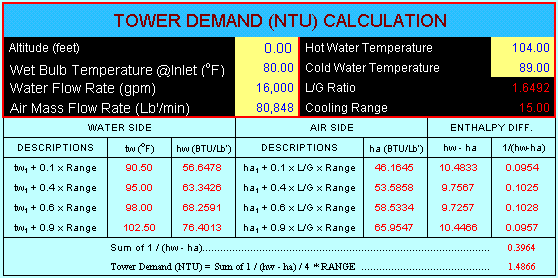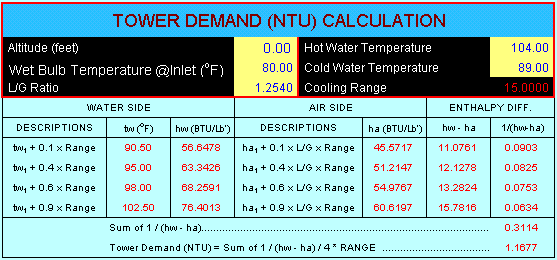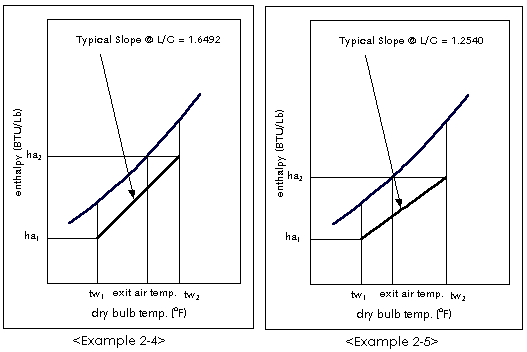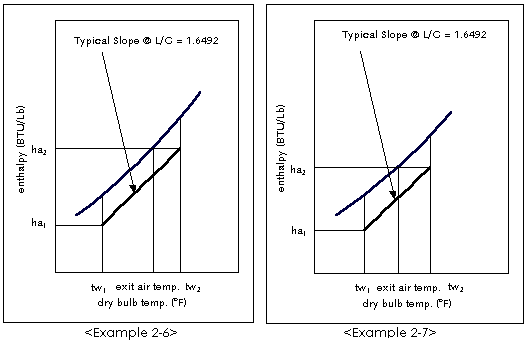|
It is very convenient to use the below tool in
calculating NTU.

Download
the example file(exe2_4.zip)
Example 2-5.
Compare NTU at the same given conditions as above
example 2-4 excepting L/G = 1.2540.
(Solution)

Download
the example file(exe2_5.zip)
(This file covers the examples of 2-6 & 2-7.)
The NTU at L/G = 1.2540
is smaller than NTU at L/G = 1.6492 under the
same design conditions. What the L/G is reduced
to 1.2540 from 1.6492 under the same water flow
rate means that the air mass is increased. In
other word, the decrease of L/G for the same water
flow rate means the decrease of enthalpy in the
air side and a value of 1 / (hw - ha) is consequently
decreased. Also, the exit enthalpy per pound dry
air is decreased and the temperature of exit air
is reduced.

In the actual cooling
tower, what the water is evenly distributed on
the entire top of fill is very rare. If the temperature
is measured onto the top of drift eliminator,
the temperature at the area where the water is
smaller than other locations is always lower than
the water is larger. This is because the air at
the area where the water is small can go easily
up due to less pressure drop with the water loading.
Example 2-6.
Compare NTU at the same given conditions as above
example 2-4 excepting that the ambient wet bulb
temperature has been changed to 81.0oF
from 80.0oF.
(Solution)
|
WATER SIDE |
AIR SIDE |
ENTH DIFF. |
|
Descriptions |
tw (oF) |
hw (But/Lb) |
Description |
ha (Btu/Lb) |
1/(hw-ha) |
|
tw1
+ 0.1 x R |
90.50 |
56.6478 |
ha1
+ 0.1 x L/G x R |
47.2587 |
0.1065 |
|
tw1
+ 0.4 x R |
95.00 |
63.3426 |
ha1
+ 0.4 x L/G x R |
54.6800 |
0.1154 |
|
tw1
+ 0.6 x R |
98.00 |
68.2591 |
ha1
+ 0.6 x L/G x R |
59.6276 |
0.1159 |
|
tw1
+ 0.9 x R |
102.50 |
76.4013 |
ha1
+ 0.9 x L/G x R |
67.0489 |
0.1069 |
|
Sum
of 1 / (hw - ha) |
0.4447 |
|
Total Tower Demand
(NTU) = Cooling Range x Sum of 1 / (hw -
ha) |
1.6677 |
Through this example,
the higher ambient wet bulb temperature (approach
is smaller), the larger NTU. That is, the enthalpy
driving force (hw - ha) is reduced as the ambient
wet bulb temperature is increased. This means
that less driving force requires more heat transfer
area or more air. (Sometimes, NTU calls "Degree
of Difficulty".)
Example 2-7.
Compare NTU at the same given conditions as above
example 2-4 excepting that the entering water
temperature has been changed to 101.0oF
from 104oF.
(Solution)
|
WATER SIDE |
AIR SIDE |
ENTH DIFF. |
|
Descriptions |
tw (oF) |
hw (But/Lb) |
Description |
ha (Btu/Lb) |
1/(hw-ha) |
|
tw1
+ 0.1 x R |
90.20 |
56.2283 |
ha1
+ 0.1 x L/G x R |
45.6697 |
0.0947 |
|
tw1
+ 0.4 x R |
93.80 |
61.4808 |
ha1
+ 0.4 x L/G x R |
51.6068 |
0.1013 |
|
tw1
+ 0.6 x R |
96.20 |
65.2631 |
ha1
+ 0.6 x L/G x R |
55.5648 |
0.1031 |
|
tw1
+ 0.9 x R |
99.80 |
71.4001 |
ha1
+ 0.9 x L/G x R |
61.5019 |
0.1010 |
|
Sum
of 1 / (hw - ha) |
0.4001 |
|
Total Tower Demand
(NTU) = Cooling Range x Sum of 1 / (hw -
ha) |
1.2004 |
This example presents
that the smaller range under the same approach,
the smaller NTU.

|
COMPARISON TABLE |
| Descriptions |
Exe. 2-4 |
Exe. 2-5 |
Exe. 2-6 |
Exe. 2-7 |
| Range
(oF) |
15.0 |
15.0 |
15.0 |
12.0 |
| Approach(oF) |
9.0 |
9.0 |
8.0 |
9.0 |
| Wet
Bulb Temp.(oF) |
80.0 |
80.0 |
81.0 |
80.0 |
| L/G
Ratio |
1.6492 |
1.2540 |
1.6492 |
1.6492 |
| KaV/L |
1.4866 |
1.1677 |
1.6677 |
1.2004 |
| Driving
Force (BTU/Lb) |
10.1031 |
13.0670 |
9.0089 |
10.0073 |
| Order
of Cooling Difficulty |
2nd |
4th |
1st |
3rd |
|